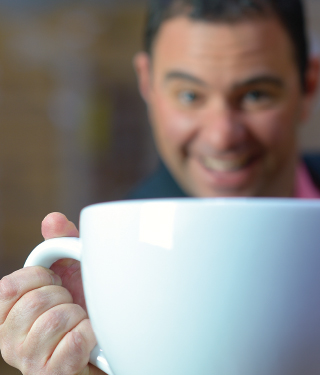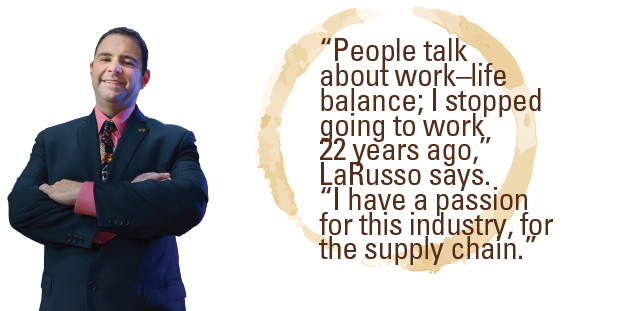
Cubicle Coffee Wars
What one blogger describes as “a turf war between two caffeine drug lords” began nearly 20 years ago when a group of female employees at a graphics company linked arms to form a protective human chain around a coffee machine.
“You’re not taking this out of the office! You’re not doing this!” they shouted at Frank LaRusso, who remembers calling his company president during the melee. “Look, Steve,” he said, “I know we have to put a formal business plan together, but I got to tell you something: Listen to this!” And he held the phone out toward the shouting women.
Right then, LaRusso knew: This is going to be huge.
That coffee machine was a FLAVIA brewer at the end of its one-month test-run in a business environment. Safe to say, it passed. Whenever you enjoy a coffee — or tea, or hot chocolate, or countless other hot beverages — from a FLAVIA or Keurig single-serve device at work, you can thank those women and Frank LaRusso for no longer having to step outside to find a great cup of Joe.
LaRusso was only 26 years old and one month beyond receiving his Drexel LeBow executive MBA in 1995 when his employer, Mars Inc., asked him to determine if its successful workplace beverage business in Europe could be replicated in North America. That’s right, Mars Inc., the same $30 billion global company that brings you pet care (Banfield Pet Hospital and Greenies), chocolate (M&M’s and Snickers), gum and mints (Wrigley and Altoids) and food (Uncle Ben’s and Suzi-Wan) is now a world leader in single-serve hot beverages in the workplace. The company provides 1 billion drinks to more than 35,000 businesses each year.
LaRusso jumped at the opportunity and became part of a two-desk operation in the corner of a facility in West Chester, Pa., that Mars was using to manufacture coin and currency receptors for vending machines. Within a year he was recruiting sales reps and setting up distributors; after the first two years of running invoices in Excel and making deliveries with Hertz rental trucks, he and his five-associate team moved into makeshift offices under a stairwell at Mars’ chocolate facility in Hackettstown, N.J.

In 2000, Mars moved its manufacturing of vending machine components from West Chester to Mexico and relocated Mars Drinks into the suburban Philadelphia facility, where it began domestic production of the packets containing coffee grounds, tea leaves or chocolate powder. In 2014, Mars will begin roasting coffee beans at the same site.
Today, LaRusso — who has been with Mars the past 22 years, occasionally wears a vest made from a burlap coffee bag to work and hears members of the Mars family refer to him as Juan Valdez — is the senior business development director for Mars Drinks. The FLAVIA brand is now affixed only to the brewing technology and the drink brands include ALTERRA® Coffee Roasters, THE BRIGHT TEA CO.® and DOVE® Hot Chocolate. The overall single-serve system is called Mars Drinks.
The workplace single-serve hot-beverage market has exploded. With an eye on worker productivity and having employees meet informally and exchange ideas around a gourmet coffee maker at work, companies have been replacing glass coffee pots with single-serve devices that can cost businesses more than twice what they previously paid.
Says LaRusso: “When someone at work says, ‘Let’s go get a cup of coffee,’ it’s really code for ‘let’s talk.’ And for the longest time, you just could not get a good cup of coffee at work. I mean, who knew how long the coffee had been sitting in that pot?”
Fully 25 percent of Fortune’s “100 Best Places to Work For” are customers of Mars Drinks — Mars, itself, is one of those best places to work — and Bloomberg Businessweek recently called Mars and Keurig “the Coke and Pepsi of cubicle coffee.”
The analogy is apt only to a point, LaRusso says. “The two of us do dominate this industry. But remember, wherever you find Coke, you’ll find Pepsi. But you won’t find Mars wherever you find Keurig.” That’s because Mars deliberately walked away from marketing its brewing system for home use to focus exclusively on providing a closed system to the vast workplace market.
“Absence of employee theft to support a caffeine habit at home is one of several distinct advantages that Mars Drinks has in the business-to-business market,” LaRusso says, including that its machines are energy efficient, they use less packaging by weight than the competition, and FLAVIA Freshpacks can be “upcycled” through a Mars Drinks program called recycleyourfreshpacks.com. In fact, Mars Drinks makes components of the FLAVIA display box and park benches out of its upcycled packets.
These “green” advantages that the Mars Drinks’ system has over its chief competitors are an outgrowth of Mars’ five principles, corporate values for which LaRusso holds a nearly messianic zeal: quality, responsibility, mutuality, efficiency and freedom.
“The Mars family gave this company the mission of manufacturing and distributing food products in ways that provide mutual benefits to the company, the customer, the planet and even our competitors,” he says. “We look for long-term relationships with office coffee-service distributors. We approach negotiations looking for the win-win.”
Having worked with IBM to sequence and analyze the entire cocoa genome, Mars publicly released the information, helping cocoa growers worldwide improve their crops’ disease resistance and yield. Mars Drinks teaches its distributors how to sell in a B-to-B market by promoting advantages beyond price and product attributes, knowing full well that those distributors will use the same techniques to sell products from competing manufacturers. Mars’ chocolate, gum and pet businesses are industry leaders in working with supermarkets and convenience stores to improve product displays and positioning, which benefits every manufacturer in those sectors. Before the launch of FLAVIA, the office-coffee business saw years of no or minimal growth.
“In every business line, we think of ourselves as the category captains,” LaRusso says. “It’s important for us to elevate the sectors we’re in.”

This is not to say that LaRusso hesitates to brag about what he views as a superior product. He can expound for several minutes on the frothy benefits of Mars Drinks’ two-packet approach to making cappuccinos and other cafe drinks vs. Keurig’s K-cup system. Or how a Mars Drinks’ packet contents, unlike the Keurig system, never come in contact with the machine, eliminating any contamination of flavors from the previous drink. Or that Mars Drinks is ranked No. 1 by its distributors for business partnership and support.
“People talk about work–life balance; I stopped going to work 22 years ago,” LaRusso says. “I have a passion for this industry, for the supply chain.” That passion led LaRusso to help impoverished coffee growers at an orphanage in El Salvador grow their own food and introduce new educational opportunities for that community’s children. Mars in turn recognized his community efforts with its global Make a Difference Award; LaRusso is the only Mars associate worldwide to win the global award twice.
The word “company” derives from the Latin cum panis, “with bread,” LaRusso points out. “The original ‘companies’ were groups coming together for a common purpose, and they would discuss their plans over dinner. The principles I learned at work are what I apply to this effort,” he says. “The real legacy is to make an impact on someone else’s life.”
[View a presentation][3] LaRusso made at Drexel about this work.
Next up for LaRusso and Mars Drinks is this summer’s introduction of [Steel Horse coffee][4]; each serving includes 150 milligrams of cocoa flavanols, a unique blend of phytonutrients that can only be found in the cocoa bean. Scientists have determined that cocoa flavanols can keep blood vessels strong and support healthy circulation. Mars will introduce the new coffee with a “fueling productivity” marketing campaign, including a ranking of the most productive companies.
“We are,” LaRusso states matter-of-factly, “still building a stronger and better cup of coffee.”


